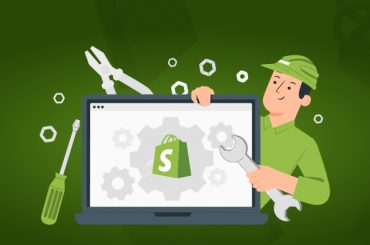What Is Dropshipping and How Does It Work? (2024)
Last Updated | January 24, 2024
Table of Contents
Dropshipping has become a popular way for entrepreneurs to start an online business without the hassle of managing inventory and shipping. In this guide, we’ll explore what is dropshipping and how it works, its pros and cons, and tips for success.
What Is Dropshipping?
It is a retail fulfillment method where a business sells products to customers without an inventory. This eliminates the hassle of purchasing and storing goods for the business owner.
The literal dropshipping meaning is that the retailer joins hands with a third-party supplier or manufacturer. That entity then handles product storage, packaging, and shipping.
The appeal of minimal upfront costs and operational flexibility has made it a popular choice among resellers. Hence, many people looking to enter the eCommerce industry want to know what is drop shipping and how they can be a part of it.
What Is a Dropshipper?
A DropShipper can be an entrepreneur or business entity that contributes to the business model. They work as an intermediary between suppliers and customers.
They operate an online store without acquiring physical inventory. They collaborate with third-party suppliers who manage everything from storage to shipping. The DropShipper only buys and resells items from the supplier once a customer places an order.
Their prime focus mostly remains on marketing, customer service, and building an online existence to attract buyers.
They know how to leverage the benefits of low initial investment, flexibility, and scalability. Therefore, they aim to create a profitable business by connecting consumers with a variety of products without the need for traditional inventory management.
How Does Dropshipping Work?
It works by establishing an online store and selecting products to sell. Whenever a customer places an order, the product details and payment information are forwarded to the supplier. They fulfill the order with no interference from the DropShipper.
DropShipper profits from the difference between the retail price and the wholesale price after they have sold a product. This model allows for a low initial investment with flexibility. People can run their eCommerce business from anywhere with an internet connection.
Success in this business model depends on market research, careful selection of vendors, and a focus on customer satisfaction. All this is to create a balance and build a sustainable online business.
Related read: How to Start Dropshipping in Canada on Shopify
Benefits of Dropshipping
Low Initial Investment
This business model uses the low entry barrier to test multiple products and niches without committing substantial capital upfront. It also emphasizes the new market entry, making it easier for new entrepreneurs to enter the market without the financial burden.
No Inventory Management
It is a time-saving method as it does ask for managing the stock. This way, a reseller can allocate more time to customer service, marketing, and business growth.
It further reduces storage costs as well. This eliminates costs associated with storage facilities and warehousing.
Wide Product Range
It quickly adapts to market trends by removing or adding products without the constraints of managing physical stock. The wide range of products also offer seasonal Items. It effortlessly introduces seasonal products without worrying about leftover inventory.
Flexibility and Mobility
Remote working is one of the biggest advantages of this profession. You can leverage the ability to work remotely, allowing you to explore new markets and stay connected while on the move. This way, you can get global reach and access to a global customer base without needing a physical storefront.
Reduced Risk
This business model preserves cash flow by only purchasing items after they’ve been sold. It reduces the risk of tying up capital in slow-moving inventory. Another reduced risk includes market validation. Testing product demand before committing to large quantities minimizes the risk of investing in unpopular items.
Scalability
It efficiently scales your business without the complexities of managing growing inventory levels and ensuring a smoother expansion process. Entrepreneurs can easily enter new markets or expand product offerings to grow their business organically.
Focus On Marketing and Sales
This model devotes more attention to building customer relationships by improving the overall buying experience. Moreover, you can also opt for marketing innovation by experimenting with innovative marketing strategies to attract and retain customers.
Low Overhead Costs
As stated above, this business model operates with leaner operations because you don’t need to invest in physical infrastructure for storing and managing inventory. The same goes with competitive pricing: The products’ prices are comparatively lower due to low overhead, potentially attracting a larger customer base.
Related read: Best Tips for Dropshipping from Amazon to Shopify 2024
Drawbacks of Dropshipping
Dependency on Suppliers
Relying on third-party suppliers can lead to stockouts, shipping delays, or sudden product unavailability. Apart from that, the DropShipper also has limited control over product quality and fulfillment processes, which can impact customer satisfaction.
Low-Profit Margins
To handle competitive pricing pressure, DropShipper set low-profit margins. Seeing the intense competition can lead to lower profit margins, making it challenging to sustain a profitable business. On the contrary, there are high advertising costs involved to stand out in a crowded market that can further eat into profits.
Shipping Issues
One of the major drawbacks includes shipping timings. Longer shipping times from international suppliers may result in client dissatisfaction and potential order cancellations. Similarly, fluctuating shipping costs can affect overall product affordability and competitiveness.
Limited Brand Control
There is a limited ability to control branding, packaging, and overall customer experience. It can impact brand perception. Secondly, difficulty building strong brand loyalty due to a lack of control over product presentation and branding also affects brand loyalty.
Product Quality Concerns
Dealing with returns and refunds can be complex, especially when customers receive products they are not satisfied with. Also, managing customer expectations regarding product quality without physically inspecting and handling inventory is challenging.
Intense Competition
Remember, many niches in eCommerce are saturated, making it challenging to differentiate and establish a unique selling proposition. This business requires the owner to copy trends as well. So, rapid replication of successful products by competitors can lead to market saturation and decreased profitability.
Customer Service Challenges
Potential delays in responding to customer inquiries or addressing issues due to the involvement of multiple parties in the supply chain can be troublesome. So, the limited control over the fulfillment process can result in difficulty in providing accurate shipping and tracking information.
Inventory Management Complexity
Challenges in managing inventory levels and ensuring that suppliers have sufficient stock to meet customer demand is a crucial part of the process. Sometimes the product goes out of stock too. At other times, the product becomes unavailable without warning, leading to unfulfilled orders and disappointed customers.
It’s important for entrepreneurs to carefully consider these drawbacks once they learn what is dropshipping. And implement strategies to mitigate potential challenges.
Related read: Best Ways to Start Shopify Dropshipping in UAE and Dubai 2023
Start Your Dropshipping Business With Shopify
If you want to initiate your business with confidence, consider Shopify as your trusted platform. Its user-friendly interface empowers every passionate, seasoned business owner to effortlessly build and customize their online stores.
The vast array of apps available in the Shopify App Store is everything you need to prepare for how to start dropshipping. The platform’s seamless integration with numerous payment gateways ensures smooth transactions from anywhere.
Shopify is not just a platform; it’s a partner in your prosperity. The backbone provides the tools and support you need to turn your eCommerce dreams into a thriving online reality.
On the other hand, the DropShipper is also supposed to strike a balance between the benefits and challenges. So, as you have discovered what is dropshipping, do not wait any longer. Start your journey with us to unlock the potential for a lucrative eCommerce business.
Frequently Asked Questions
How Much Do I Need to Invest to Start Dropshipping?
It requires minimal investment in website costs, marketing budget, and potential tools. Although the amount varies based on goals and strategies.
How Do Dropshippers Make Money?
Dropshippers profit from the price difference between wholesale and retail. Effective marketing and strategic product selection impact income.
Is Dropshipping Legal?
Yes, it is legal. It ensures compliance with local regulations, taxes, and consumer protection laws for a smooth operation.
How Profitable Is Dropshipping?
The profitability varies because success relies on niche selection, effective marketing strategies, and efficient operational practices.
How to Start a Dropshipping Business?
You can start by understanding what is dropshipping first to wisely choose a niche. Then, you can set up an online store (like Shopify), find reliable suppliers, and focus on effective marketing strategies.
How to Do Dropshipping?
Start dropshipping by selecting a niche, creating an online store, identifying reliable suppliers, and implementing marketing strategies. Prioritize customer service and adapt based on performance data.
What Is the Difference Between Dropshipping and Retail Arbitrage?
It means selling products without holding inventory. The DropShipper relies on suppliers to fulfill orders. On the other hand, retail arbitrage is purchasing low-priced items from retail stores and reselling them at a higher price.
Related read: Best Tips for Shopify Dropshipping Australia in 2024?









